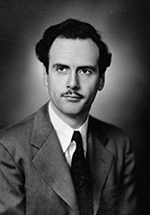Marshall McLuhan

Marshall McLuhan was a Canadian academic, writer, and media theorist who in the 1950s and 1960s foresaw many of the communication and technological advances which we have today.
Herbert Marshall McLuhan was born in Edmonton, Alberta, in 1911. When WWI started his father, Herbert enlisted in the Canadian Army but remained in Canada and was discharged in 1915; then the family moved to Winnipeg, Manitoba. McLuhan began his studies at the University of Manitoba in 1928, earning a B.A. in 1933 and an M.A. in English in 1934. He then entered Trinity College, Cambridge in 1934 and studied under literary scholars, F.R. Leavis and I.A. Richards, promoters of the New Criticism. After two years of study in the U.K. he returned to North America to teach English at the University of Wisconsin--Madison (600 miles south of Winnipeg). In 1937 he converted to the Roman Catholic Church and began teaching at the Catholic institution, St. Louis University (1937 - 1944). There he met and married Corinne Lewis. The married couple spent 1939-40 back at Cambridge where McLuhan completed his M.A. (his second) and began work on his Ph.D. on Thomas Nashe and the arts of language. Because of WWII he was permitted to complete his dissertation back in the U.S. and received his doctorate in 1943. He and Corinne then returned to Canada where he taught English at Assumption College in Windsor, Ontario, from 1944-46. In 1946 they moved to Toronto when McLuhan joined the staff of St. Michael's College at the University of Toronto, he remained there until his death in 1980 at age 69.
One of his graduate students was Edmonton writer and academic Sheila Watson who wrote, The Double Hook (1959). He supervised her Ph.D. thesis on Wyndham Lewis (1959-65). McLuhan had met Lewis when he lived in Canada during WWII and had invited him to come to St. Louis University in 1943. Later they both lived in Windsor, Ontario. Lewis, an English artist and writer was one of the founders of Vorticism in 1914, an avant-garde movement from England.
During his teaching and writing career, McLuhan received much recognition and many awards. In November, 1971 the University of Alberta awarded him an Honorary Doctor of Laws degree. The University of Toronto created the Centre for Culture and Technology in 1963 to promote his research and publications. McLuhan spent the rest of his career as Director of this centre.
Major Books by McLuhan
His first major book was The Mechanical Bride: Folklore of Industrial Man (1951) which is now recognized as a pioneering work on popular culture. It is organized as a collection of essays, each of which begins with an image and printed ad from a magazine. McLuhan proceeds to critically analyse the style, and symbolism of the ad, the aesthetic references and the object of persuasion behind it. This reading of modern advertising was his method of identifying the values and obsessions of modern society. McLuhan was influenced by Wyndham Lewis' book, The Death of Youth (1932) and by F.R. Leavis' Culture and Environment (1933).
McLuhan's second book, The Gutenberg Galaxy: The Making of Typographic Man (1962) begins with print culture then expands into cultural studies and media technology. This dense exploration of communication technology has many literary references as examples of how changes in technology affect human cognition and also social organization. In this book he introduced many terms and concepts which have since been identified with his philosophy: the mosaic method (7), the global village (43), alphabetic man (88), typographic logic (254), mass man (314). McLuhan's books are often structured as collections of essays which are organized by the association of ideas, following his mosaic method.
His third book, Understanding Media: The Extension of Man (1964), builds on the previous book on print culture in order to explore the theory of media. McLuhan's central argument there is that the technology of different media should be the focus of critical analysis, rather than only the content that they may transmit. This idea is captured in the phrase "the medium is the message." There he also introduces the distinction between hot and cool media. This volume along with The Gutenberg Galaxy are now recognized as major contributions to the modern studies of communication and communication theory. Later researchers have applied McLuhan's ideas to the analysis of digital technology.
The Medium is the Massage: An Inventory of Effects (1967) which McLuhan produced with Quentin Fiore, a graphic designer, explores the effects each medium has on sensory perception. Thus the use of the term, 'massage,' in the title.
From Cliché to Archetype (1970) which McLuhan produced in collaboration with Alberta poet, Wilfred Watson carries on the project of the previous books. The two authors use many literary examples in order to explore the use of clichés and archetypes.
There is now a great deal of information and analysis of McLuhan's books and ideas on many internet sites. Many of his publications are now in e-book format. Through his work in media McLuhan anticipated the development of the World Wide Web and the fact that his work is now disseminated by digital technology seems an ironic answer to his early critics.
The McLuhan Legacy in Alberta

McLuhan House in Edmonton
The McLuhan House in Edmonton was restored in 2015 as a Centre for the Arts and Ideas and as a Municipal Historic Resource. The address is 11342 - 64 Street, Edmonton, 6 blocks east of Wayne Gretzky Drive. Here you will find a good deal of information on the McLuhan family background in Alberta. (McLuhan House photo by J. Pivato)
Edmonton is the birthplace of Athabasca University (1972), the major online university in Canada. Most of the courses use the new media technology that McLuhan foresaw in the 1960s. Athabasca also has a new Communications Studies program, a area of study pioneered by McLuhan. Another irony is that one of the first literature and culture courses at Athabasca was written in 1977 by Sheila Watson, his former student. The course was called Modern Consciousness and focused on one of McLuhan`s favourite authors, James Joyce and demonstrated his mosaic method for textual analysis. (Pivato, Sheila Watson, 207-220)
There is also a Herbert Marshall McLuhan Graduate Student Award in the Master of Arts in the Communications Technology program, Faculty of Extension, University of Alberta, Edmonton.
Updated April 25 2016 by Student & Academic Services